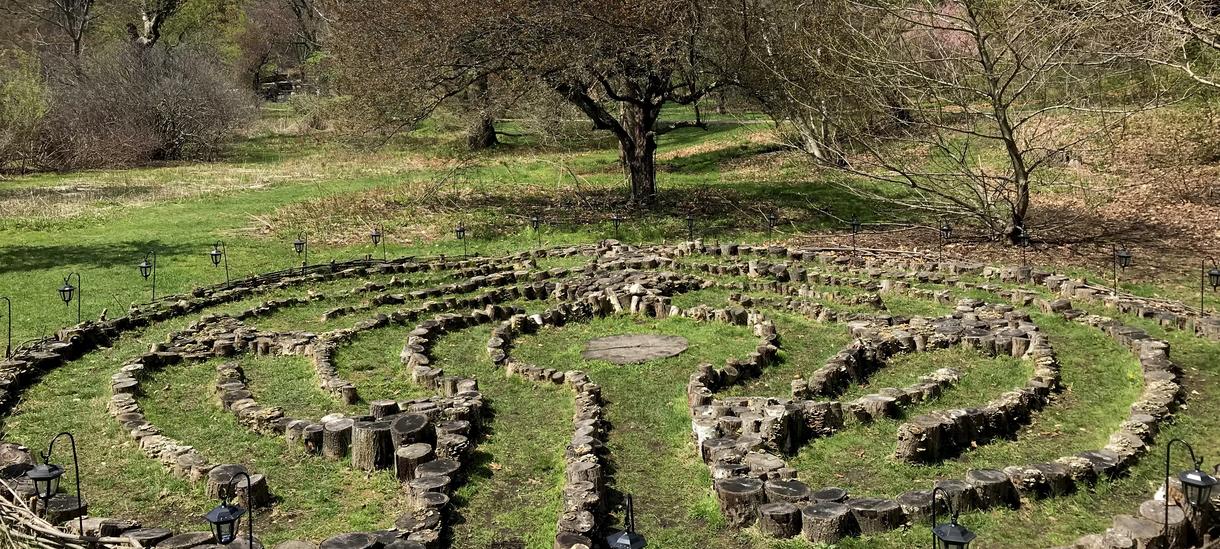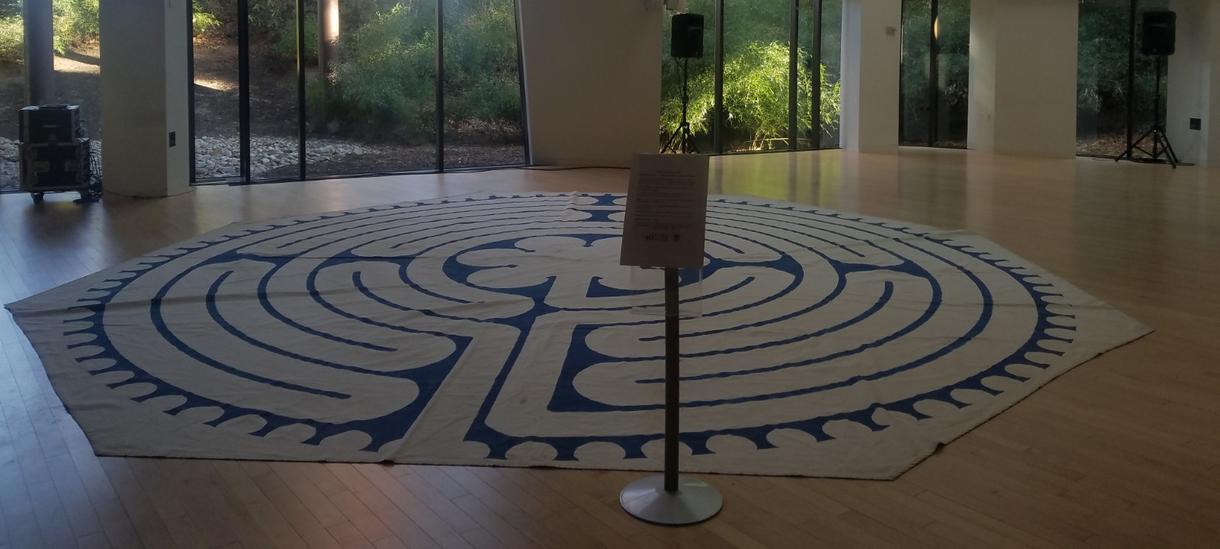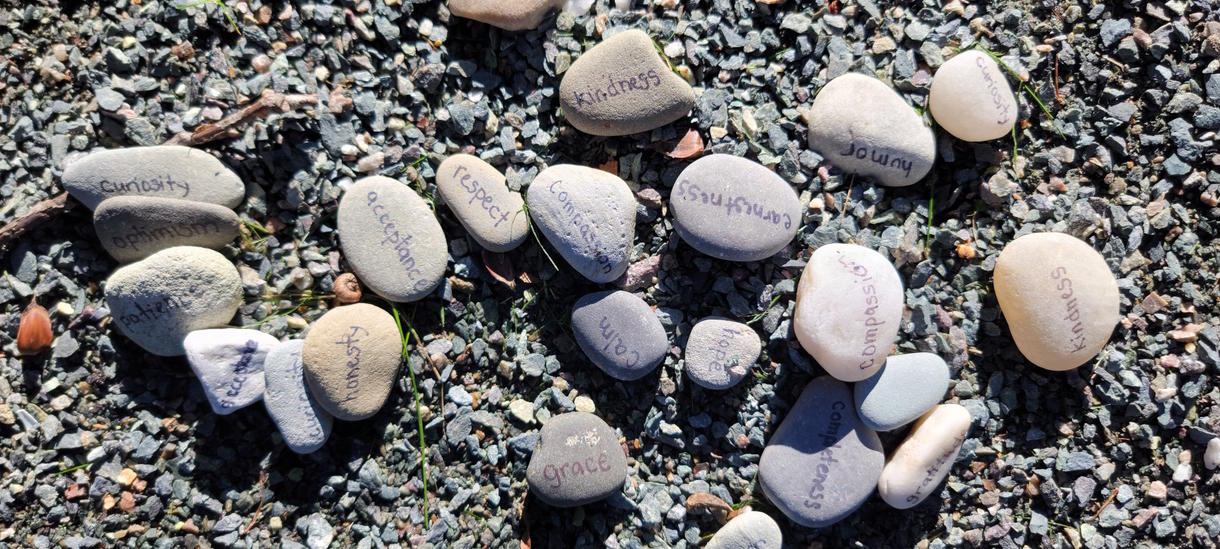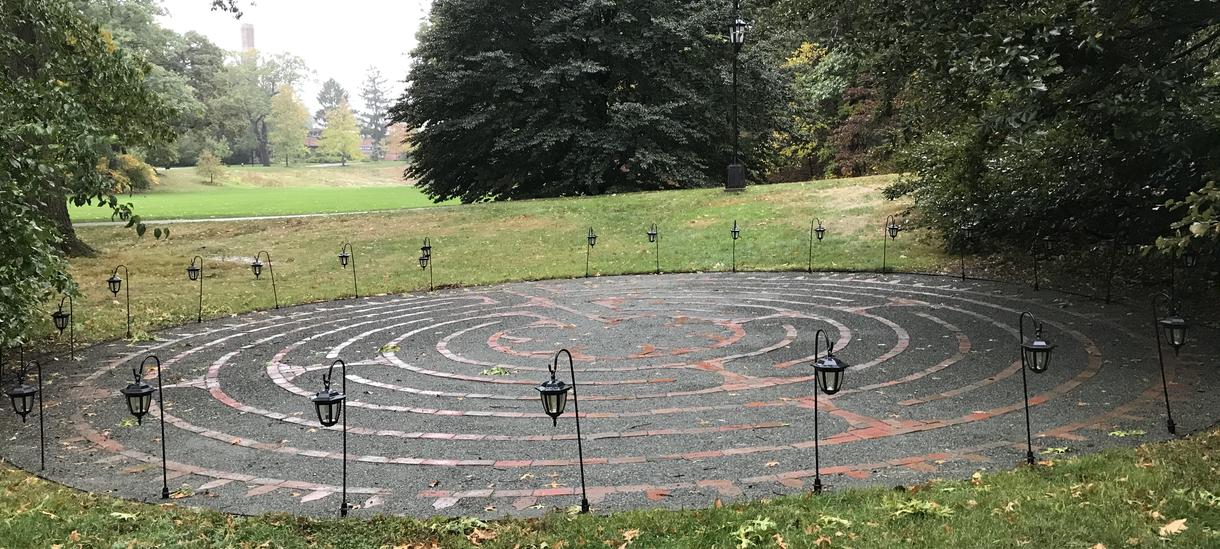Wellesley College Labyrinths
The Labyrinth Project at Wellesley College is generously funded by Laura Becker-Lewke, Class of 1977.
In 2012, Becker-Lewke gifted the College with a large canvas labyrinth to introduce the practice to the campus. Eager to engage students in spiritual reflection through contemplative practice, she dreamed of one day building an outdoor labyrinth that might invite curious walkers on an unexpected journey.
The Houghton Chapel Labyrinth
The indoor labyrinth in Houghton Chapel is a canvas replica of the 11- circuit medieval labyrinth of Chartres Cathedral in France. This pattern, once central to cathedral culture, was inlaid into the stone floor in 1201 at Chartres Cathedral. The cloth labyrinth is used for ORSL contemplative programs with students and is laid out in the chapel transept. Open when the chapel is open. Shoes are requested to be taken off for use of this labyrinth.
In 2017, in partnership with Rev. Dr. Lauren Artress at Veriditas and master labyrinth builder Lars Howlett at Discover Labyrinths, ORSL sponsored a year-long series of workshops (introduction, exploration and building of labyrinths) in which students designed and handcrafted an outdoor naturally sourced labyrinth in the Botanic Gardens.
The Botanic Garden Labyrinth
The outdoor labyrinth nestled beside Paramecium Pond was designed and built by students and ORSL, with the support and guidance of master labyrinth builder Lars Howlett. It is a five-circuit medieval labyrinth crafted from trees recovered from the Wellesley College campus. The centerpiece is a cross-section of an original planting to the College, more than 150 years old. All of the materials were sustainably sourced from campus, making the labyrinth a living embodiment of the College’s commitment to contemplative practice. This naturally sourced labyrinth was made and planned to revert back to nature over the years.
In 2019, master labyrinth builder Lars Howlett designed a more permanent stone labyrinth for the college, which was completed in 2020 and dedicated in 2022.
The Munger Meadow Labyrinth
The outdoor labyrinth, made of stone materials, is located near the walking path by Munger Meadow near the Science Center. It was designed by master labyrinth builder Lars Howlett. This labyrinth was constructed as a more lasting labyrinth and is used for contemplative sessions with students. Solar lights are available in non-inclement weather as well. Open daily.
At the dedication, Laura Becker Lewke '77 shared, "...Our vision is for interfaith connection and communication as well as welcoming individuals with no particular faith or spiritual practice...One of the reasons I so appreciate the labyrinth is that it brings us together in our common humanity, walking along the path of life. It encourages us to see what we have in common as opposed to focusing on our differences."
The Labyrinth is a circular pattern with one path that winds its way in a circuitous fashion into the center. Distinct from a maze, which is designed to confuse the walker, the labyrinth provides a clear, highly structured path that focuses and quiets the mind and opens the heart. Walking the labyrinth has become a practice that many people embrace to reduce stress, provide reflection and replenish our energy.
Labyrinths date back four to five thousand years. In the Middle Ages, many of the pilgrimage cathedrals had labyrinths. Once the crusades made it dangerous to travel, labyrinths became a symbolic way to enact the journey to Jerusalem. The only surviving medieval labyrinth is the Medieval Eleven-Circuit labyrinth inlaid in the floor of Chartres Cathedral in France in the year 1201.
The use of labyrinths has been revived in the last 20 years, largely through the efforts of Rev. Dr. Artress, who is considered the founder of the modern labyrinth movement. Her book, Walking a Sacred Path; Rediscovering the Labyrinth as a Spiritual Practice is the standard introduction to the subject. A second book of Meditations is included in the Sand Labyrinth Kit and her third book The Sacred Path Companion: A Guide to Using the Labyrinth to Heal and Transformwas published in March 2006. Lauren is the Founder of Veriditas, a non-profit dedicated to the transformation of the human spirit.
"Based on the circle, the universal symbol for unity and wholeness, the labyrinth sparks the human imagination and introduces it to a kaleidoscope patterning that builds a sense of relationship; one person to another, to another, to many people to the creation of the whole. It enlivens the intuitive part of our nature and stirs within the human heart the longing for connectedness and the remembrance for our purpose of living." - Lauren Artress
Today the labyrinth is a transformational tool for reconnecting people of all faiths with their spiritual grounding.
Walking the Labyrinth
The labyrinth can be walked in four stages. As you encounter other people walking the same path, simply allow them to pass. You walk the labyrinth with your body and rest your mind.
- Remember before walking the labyrinth - Take time in gratitude, be thankful for your life. Bless the people in your life. If there is a specific event or situation troubling you, bring it to mind and form a healing question if possible.
- Release walking into the labyrinth - This is the time to quiet the mind, let go of the mind chatter and release your troubles. Open your heart to feel whatever it may feel. Become aware of your breathing. Take slow breaths. Relax and move at your own pace.
- Receive standing or sitting in the center - This is a place of reflection. Pause and stay as long as you like. Open yourself to your higher power. Listen to that small inner voice. In the safety of the labyrinth, have a heart-to-heart talk with yourself.
- Return walking out of the labyrinth - When you are ready, begin walking out the same path you followed in. Walking out, integration of your experience happens. Experience the sense of well-being, healing, excitement, calm or peace.
Adapted from Veriditas.org
For more information about labyrinths, we invite you to visit Veriditas.
To find other labyrinths near you, please check LabyrinthLocator.com.
Contact: Office of Religious and Spiritual Life | Billings 2nd floor | ORSL@wellesley.edu | 781.283.2685




